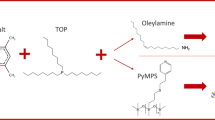Abstract
We apply an in situ approach, whereby a polymer is incorporated into copper and evolves within the metal into the ceramic phase, to create a dispersion of hard particles in a metal. All constituents for the ceramic phase are contained within the organic polymer. The temperature for this polymer to ceramic conversion lies in the 1073 K to 1273 K (800 °C to 1000 °C) range. The process produces a nanoscale dispersion of the ceramic, which leads to high microhardness that remains unaltered at temperatures up to 1223 K (950 °C) (0.9T M). Apparently, the introduction of the ceramic phase leads to the retention of copper crystallite size of a few hundred nm, despite exposure to heat treatments at these very high temperatures. We call these materials polymer-derived metal-matrix composites.













Similar content being viewed by others
References
D. Hull, Introduction to Dislocations, 5th Edition. Butterworth Heinemann Elsevier, NY,2011.
J. W. Christian, The Theory of Transformation in Metals and Alloys, Pergamon Press, 3rd Edition, 2002.
J. Groza, J. Mater. Eng. and Performance, Vol. 1, p. 113 (1992).
Sudarshan, M. K. Surappa, D. J. Ahn, and R. Raj, Metall. Mater. Trans. A, Vol. 39A, 2008, 3291–97.
E. Kroke, Y-L. Li, C. Koetschny, E. Lecomt, C. Fasel and R. Riedel, Mater. Sci. Eng. Reports, Vol. 26, 97-199 (2000).
L. Pederiva, G. D. Sorarù, J. Latournerie and R. Raj, J. Amer. Ceram. Soc., Vol 85[9], 2181-2187 (2002).
A. Saha, D. L. Williamson, and R. Raj, J. Amer. Ceram. Soc., Vol. 89[7], 2188-2195 (2006).
J. Bill, J. Schumacher, K. Muller, J. Seitz, J. Durr, H. P. Lamparter, J. Golczewski, J. Q. Peng, H. J. Seifert, and F. Aldinger, Zeitschrift fur Metallkunde, Vol. 94, 335-351 (2000).
L. An, R. Riedel, C. Konetschny, H.-J. Kleebe and R. Raj, J. Amer. Ceram. Soc., 81 [5], 1349-1352 (1998).
S. R. Shah and R. Raj, Acta Materialia,, 50[16], 1359-6454 (2002).
Y.-L. Li, E. Kroke, R. Riedel, C. Fasel, C. Gervais, and F. Babonneau, Appl. Organometall. Chem., 15, 2001, pp. 820–832.
H.-Y. Ryu and R. Raj, J. Amer. Ceram. Soc., 90[1], 295-297 (2007).
Acknowledgments
This research was supported in part by the University of Trento, Italy, and in part by the Division of Materials Research at the National Science Foundation of the United States (DMR1105347).
Author information
Authors and Affiliations
Corresponding author
Additional information
Manuscript submitted October 17, 2011.
Rights and permissions
About this article
Cite this article
Castellan, E., Ischia, G., Molinari, A. et al. A Novel In Situ Method for Producing a Dispersion of a Ceramic Phase into Copper That Remains Stable at 0.9T M . Metall Mater Trans A 44, 4734–4742 (2013). https://doi.org/10.1007/s11661-013-1835-3
Published:
Issue Date:
DOI: https://doi.org/10.1007/s11661-013-1835-3




